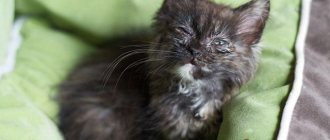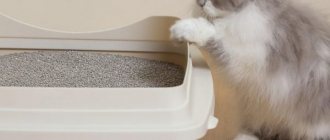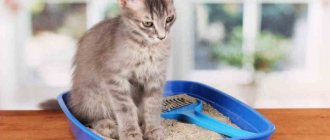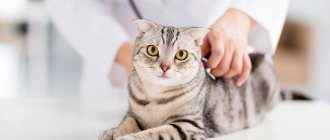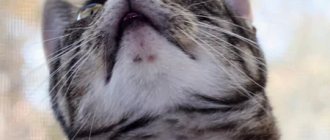It's funny when a cat sneezes, but a runny nose in cats is most often the cause of a cold, which is not dangerous for the animal if treated. But, unfortunately, in domestic cats, nasal discharge can indicate allergies and serious diseases. The correct diagnosis will be made by a veterinarian. Our article is about the causes of a runny nose, what to do if a cat sneezes , types of nasal diseases accompanied by a runny nose, and how to treat an animal at home.
How to tell if your cat has a cold
Cats get colds for the same reasons as people get colds. Cats of any age can develop a runny nose. Hypothermia and drafts cause colds. If after bathing the cat was on a cold floor or in front of an open window and after that the cat sneezes, be sure that she has a common cold.
The causes and symptoms of colds in cats are as follows:
- increased body temperature (measured through the anus. Normal cat body temperature is 38 degrees).
- hot nose, ears, paw pads.
- The cat sneezes and coughs periodically.
- weakness.
- lack of appetite.
— the cat mostly sleeps.
Another additional symptom of a cold is watery eyes.
Treatment of colds in cats
When treating a cold for the first 24 hours, you can use traditional methods: provide the cat with warmth, food in the form of warm milk, vitamins, grass, and, if possible, massage her paws. This will increase blood flow, which will speed up recovery.
Clean your nose and eyes with a cotton pad. For this, chlorhexedine or a weak solution of potassium permanganate is useful.
We recommend rinsing your nose with one of the following options:
1. Novocaine 1% + Adrenaline.
2. Tannin 0.5%.
3. Ethacridine 0.2%.
4. Zinc sulfate – 2%.
If your eyes begin to fester and the nasal discharge changes in consistency, switch to the antibiotics Tobrex or Ciprofloxacin.
NEVER give your cat paracetamol. The composition of the medicine is toxic to cats and can cause severe internal bleeding.
Usually these measures help the animal overcome a cold.
What to do if your cat sneezes at home
Depending on the symptoms accompanying sneezing, it is possible to help the animal yourself.
Thus, dust ingress is the most harmless cause of a defensive reaction. High-quality cleaning or removing the animal from a dusty room can solve the problem. Keeping your home tidy will prevent foreign matter from entering your respiratory tract.
If an allergy occurs, the first aid should be to remove the allergen from the animal. You can change the cleaning agent or choose a different type of filler. If there is a reaction to pollen, remove the flowering plant from the cat’s access, or remove the stamens in a timely manner. Usually these actions are enough to eliminate the negative impact.
As a preventative measure against colds that cause sneezing, you should give your pet multivitamins and feed him a balanced diet.
Any self-medication is dangerous for the cat; you should not postpone a visit to a specialist so as not to worsen his condition.
Symptoms and treatment of laryngitis
Laryngitis in cats is an inflammation of the laryngeal mucosa. It occurs due to hypothermia of the animal, feeding very cold or icy food, prolonged exposure to the cold, as well as chemical odors and smoke. Laryngitis can also be caused by allergies. We recommend not to make a diagnosis on your own and not to experiment with medications. Laryngitis accompanies rabies and tuberculosis, and the symptoms of the disease can easily be confused with calcivirosis and rhinotracheitis.
The disease is manifested by wheezing, difficulty swallowing, lack of appetite, weakness of the animal and prolonged sleep. Body temperature usually remains normal or slightly elevated. Sometimes vomiting appears after coughing - this is due to inflammation of the larynx.
Treatment: When the cat sneezes and coughs
Warmed food, water, milk, and broth will help cope with laryngitis. Do not give dry food - so as not to irritate the throat mucosa. Switch temporarily to feeding wet food or natural food.
Keep your pet warm - do not bathe him under any circumstances until he recovers, and do not expose him to drafts.
Bromhexine and mucaltin will cure a cat's cough.
If laryngitis is a consequence of allergies, the use of Diphenhydramine or Prednisolone is appropriate.
It is also appropriate to apply dry compresses (heated salt wrapped in cloth) to the cat's neck area.
To cure a runny nose in a cat, bury the nose with sea buckthorn oil - it has an antibacterial effect and heals the mucous membrane.
How to help a sneezing cat
If, at the time of the appearance of sneezes, the purr does not have the opportunity to consult a doctor, you need to try to alleviate the pet’s suffering at first and prevent the development of the suspected disease.
First aid
If sneezing is caused only by external reasons, it is necessary to eliminate irritating factors. For example, clean the animal’s face from dust in which the fur has become dirty, or ventilate the room from strong odors.
Clearing mucus from the eyes and nose will ease your cat's condition when sneezing with a runny nose.
When the cat continues to sneeze continuously, you need to urgently take other measures - wipe the eyes with a 0.05% solution of chlorhexidine or a weak solution of potassium permanganate (moisten a cotton swab in the liquid, squeeze it out and wipe the affected areas). Then arm yourself with a syringe without a nozzle and rinse your pet’s nose with saline solution or chlorhexidine, after removing the crusts around the nostrils.
In order for the washing to be successful, it is necessary:
- Heat saline solution or chlorhexidine in a water bath to a temperature of no more than 37 degrees.
- Place the cat on its back, securing its limbs tightly (you can “swaddle” it in a towel).
- Draw liquid into the syringe and lift the animal’s muzzle.
- Gently place two to four drops into each nostril, without touching the nose.
- Make sure that the solution gets into the nasal passages.
- Allow the animal to rest and repeat the procedure twice.
- Clean the cat's face from any secretions.
After which it is important to pack your pet “for the road” and go to an appointment with a veterinarian. At the clinic, the furry cat will be given the correct diagnosis and treatment will be prescribed in a timely manner.
Video: how to rinse a cat's nose
Medications
A visit to the veterinarian will help determine medications that will help rid the animal of the disease. It is impossible to treat purring with drugs on your own, because the result can be not only zero, but also negative. It is important to take a responsible approach to solving your pet’s health problem and carefully follow the doctor’s recommendations.
Medicines should be given to the cat in strict accordance with the veterinarian’s recommendations.
Depending on the cause of sneezing, a treatment regimen is developed.
So, for a cold, instillation of 2-3 drops into the nostril is prescribed:
- 0.5% solution of novocaine (for pain relief), mixed in a 1:1 ratio with adrenaline (has a vasoconstrictor and anti-edematous effect);
- 0.2% solution of ethacridine (characterized by an antiseptic effect without irritation of the mucous membranes);
- 2% solution of zinc sulfate (anti-inflammatory, antibacterial and drying agent).
If the condition worsens (pus appears in the eyes and discharge from the nose thickens), the doctor selects antibiotics like Tobrex (tobramycin-based eye drops) or Ciprofloxacin (a bactericidal agent from the fluoroquinolone group).
Photo gallery: cold medicine for cats
Ciprofloxacin will help eliminate suppuration in the cat’s eyes
Novocaine is poured from ampoules into a clean container and drawn into a pipette
Tobrex drops are prescribed for conjunctivitis in cats
It is forbidden to give paracetamol-based medications to cats, as this substance provokes internal bleeding in purring cats.
When a cat gets laryngitis, in addition to drops, they also treat it for cough:
- give 1 tablet of Bromhexine 3 times a day after meals - the drug stimulates expectoration and makes sputum sticky;
- add one Mucaltin tablet to the food no more than 3 times a day - a medicine based on marshmallow root promotes better separation of mucus from the bronchial walls due to its softening and enveloping properties.
And if laryngitis develops due to allergies, antihistamines (for example, Diphenhydramine) are added to the treatment. The dosage of medications and the order of administration are determined by the veterinarian depending on the condition, age and weight of the animal.
For rhinitis, treatment is done as follows:
- the eyes are wiped with chlorhexidine (the safest and most effective antiseptic);
- Galazolin is instilled into the nose (two drops three times a day), a vasoconstrictor based on imidazole;
- make injections of Gamavit (2 ml per kg of body weight 2-3 times a day for 5 days) - an immunomodulator for animals, in order to maintain the protective functions of the body;
- Doxycycline is given orally (half a tablet per kg of weight on the first day, 1/10 of a tablet per kg of weight for two more days) - an antibiotic from the tetracycline group, suppresses the proliferation of pathogenic microbes.
Photo gallery: medications for rhinitis in cats
Gamavit has a supporting effect on the animal’s immunity
Galazolin is most often prescribed by veterinarians for runny noses in cats.
Chlorhexidine is an effective and safe antiseptic
Doxycycline will help rid your cat of a viral infection
In addition, injections of Fosprenil (an antiviral drug for animals) are prescribed at a rate of 0.5 ml per kg of pet weight. The course of therapy is one week.
If a veterinarian has diagnosed sinusitis in a cat, you will need to get rid of the disease like this:
- lubricate the nasal openings with Oxolin in the form of an ointment (an antiviral drug that “works” in direct contact with the infected area);
- instill in the nose a 0.1% solution of a broad-spectrum antiseptic - Furacilin (3 drops in each nostril 4 times a day);
- rinse your nose with a 15% solution of Maxidin (two to three times a day for a week) - an immunostimulating drug when infected with a viral infection.
The doctor may also prescribe penicillin-based antibiotics if the disease is advanced and the therapy has not produced results.
Important! Before each treatment session, you need to thoroughly rinse the eyes and nose of the purr with saline solution or slightly salted boiled water.
In addition to the above remedies, the veterinarian may prescribe treatment:
- corticosteroids (hormonal anti-inflammatory) and vasodilators - for asthma;
- antihelminthics - if the cause of sneezing is helminths that have settled in the lungs.
Despite the fact that the owner will have to treat the purring independently, supervision from a specialist will be present throughout the entire course of therapy. Every week it is necessary to take the cat to see a doctor, and if the pet’s condition worsens, the mustache will be placed in a hospital.
Traditional medicine in the fight against cat sneeze
Not only medications, but also additionally used folk remedies help improve the health of purrs when sneezing due to illness. Thanks to the latter, treatment will not be prolonged, and the harm from repeated use of synthetic antibiotics will be reduced.
A salt compress can help your cat with a cold.
The main thing is to remember that such methods should not replace the main therapy, and they are effective only for diseases that do not pose a threat to the life of the cat.
So, for colds and laryngitis, you can make a compress with warm salt in the neck area. And instilling sea buckthorn oil will help heal wounds on the mucous membranes of the nose. A weak decoction of St. John's wort will prevent the proliferation of pathogenic microbes in the nose - only one drop is needed in each nostril twice a day.
Other effective remedies for sneezing and runny nose in cats belong to homeopathy and, according to the owners, relieve the disease within three days to a week:
- freshly collected aloe juice - has a pronounced antiseptic and anti-inflammatory effect, drip 2 drops into the nostril twice a day for three days in a row;
- solution of Kalanchoe juice (the anti-inflammatory qualities of the plant are combined with the ability to trigger the regeneration of epithelial tissues) - add two drops of juice to a teaspoon of warm water, drop one drop into the nostril and let the cat rest;
- decoction of chamomile and sage - 1 tbsp. l. pour a liter of boiling water over the mixture of herbs and cook for 2 minutes, leave for 2 hours in a thermos or under a lid with a towel, then rinse three times a day for a week (chamomile gives an antibacterial effect, and sage helps relieve swelling of the mucous membrane).
In my opinion, these treatment methods, although effective, should not replace drug therapy. It is not worth treating the animal with herbs on your own, without a veterinarian establishing the cause of a cat’s sneezing. After all, what we mistake for a cold can actually turn out to be a life-threatening virus for a cat - calcivirosis or rhinotracheitis.
Video: how to put drops in a cat’s nose
Warning symptoms when a cat sneezes
If the purr not only sneezes incessantly, but also looks depressed, this is a sign of the development of the disease. You need to check your pet's nose - a dry and hot tip occurs in cats at elevated temperatures.
Sneezing in cats may be a sign of a serious illness.
Other symptoms that should promptly take your cat to the vet include:
- chills;
- loose, pungent-smelling stools;
- hair loss;
- formation of wounds and ulcers on the body;
- a sharp decrease in body weight;
- nosebleeds;
- vomit;
- fear of bright light;
- unprovoked aggression;
- wheezing or wheezing breathing;
- attacks of hysterical cough.
Upon admission to the clinic, the cat will have a blood test taken for allergies and viruses, and the pet will also be examined for foreign bodies in the nose.
If there are pregnant women around the cat, even after a single sneeze, you need to take the animal to the veterinarian and take a blood test for toxoplasmosis and other viruses. After all, toxoplasma is a dangerous infection that can penetrate the intrauterine membranes and cause the death of an unborn child.
In most cases, after identifying the cause of sneezing, treatment is prescribed, which the animal owner will carry out at home.
However, surgical intervention is also possible - if cancer is detected (the tumor is excised and a course of chemotherapy is prescribed) or to remove polyps from the nasal cavity.
When a kitten sneezes
Adult cats, despite the weakening of the body due to illness, better tolerate treatment for infections and allergies against the background of constant sneezing.
Kittens who sneeze should be treated with extreme caution.
And when a kitten sneezes, you need to be much more careful and attentive. A small cat, due to its curiosity and high “penetrating ability,” can become hostage to an allergy to household dust, fragrances, or even cat food. It is important to get rid of the irritant as soon as possible and carefully monitor the pet’s condition.
First aid here comes down to wiping the eyes and nose with a cotton pad soaked in a weak solution of salt or potassium permanganate. Rinsing the nasal cavity with a syringe or pipette is difficult for children due to the small size of the respiratory organ.
It is better to monitor the animal’s health at home for no more than 2–3 days. If, after first aid, the baby’s sneezing does not stop, or his eyes begin to water or fester, you should immediately contact a veterinary clinic. Kittens have a weak immune system, so you shouldn’t delay visiting the doctor. The doctor will prescribe medications in accordance with the diagnosis and age of the purr.
Rhinitis in cats
A runny nose in cats is most often caused by a cold. Rhinitis can also be the result of an allergy - to dust, perfume, air freshener or other household chemicals. If rhinitis is not treated, it becomes chronic - then it is dangerous due to the growth of polyps and adenoids. How can you tell if a cat’s runny nose is due to an allergy? The discharge is watery, sneezing is frequent. If there is an infection, the discharge becomes colored, becomes viscous and has a specific odor.
With rhinitis, a cat's nose becomes red, especially the edges of the nostrils, wheezing is heard when breathing, and with infections - lacrimation and the formation of crusts under the eyes.
How to cure rhinitis in cats
1. Regularly treat your eyes, remove crusts with a cotton swab moistened with chlorhexedine or saline solution.
2. If you have an infectious pathogen, drip your nose with Galazolin - 2 drops.
3. Rinse the spout with saline solution - dissolve 1 ml of salt in 100 ml of water. For administration, use a syringe without a needle or a pipette with a sharp tip.
4. Treatment of a runny nose in cats is carried out with a solution of adrenaline with 1% novocaine. Naphthyzin for children is also suitable .
5. A must for boosting immunity is Gamavit.
6. If the cat is given, do inhalation by adding 2 drops of eucalyptus to the steaming water.
7. In case of complications, give Dioxycycline according to the following scheme: 1st day, half a tablet per 1 kg of weight. The next 2 days - a tenth of a tablet per 1 kg of weight.
Fosprenil - 0.5 ml/kg. Course - 7 days.
Sneezing with bloody discharge
If an animal sneezes with blood, it means that the nasal mucosa is damaged.
There are several reasons why this happens:
- ingress of traumatic foreign bodies or their prolonged presence in the nose;
- a sharp change in temperature after returning from the street;
- inflammatory process;
- muzzle injuries;
- exposure to irritants, especially aerosols.
Air fresheners, cigarette smoke, and various cosmetic sprays are very harmful to all cats. To protect the health of your pet, you need to choose high-quality household chemicals. When spraying aerosols, make sure that they do not get on the animal’s face. It is extremely undesirable for owners to smoke in the apartment; to do this, they need to go out onto the balcony or onto the street.
A single sneeze, even with blood, is a relatively safe symptom. Owners should be wary if a cat sneezes several times in a row or has bleeding from its nose. You can stop nosebleeds with a cold compress (a handkerchief soaked in cold tap water). There is no need to apply ice. Forcing a cat to raise its face is dangerous. If the compress does not help within 5-10 minutes, you need to go to a veterinary clinic.
Other possible causes of a runny nose
1. Caries. An infection in the oral cavity penetrates the nasopharynx, causing inflammation of the mucous membrane. As a result, the cat sneezes, its nose runs, and its eyes water. In this case, you need to contact a veterinarian to eliminate the cause of the runny nose.
2. Worms. Helminths are insidious creatures that can also cause runny noses in cats. Regularly - once every 3 months - give your pet anthelmintic drugs. This must be done because The cat is constantly licking something - the floor, the walls, street shoes, etc.
3. Allergies. Observe the animal's reaction to the aroma of your cosmetics/deodorants - perhaps they irritate the mucous membrane of his nose. Try to regularly clean the house of dust - it also serves as a powerful allergen for cats.
Worm infestation
Heart problems always cause a cough reflex and sneezing. Sometimes the reason that a cat begins to actively sneeze lies in heartworms , which enter the body through a mosquito bite. Some time after penetration into the blood vessel, the larva begins to grow and turns into an adult. The cause of death is blockage of the heart artery.
This disease can be fatal, but it can be successfully avoided if you sound the alarm in time.
The main symptoms indicating helminth infection are:
- noticeable weight loss;
- signs of asthma are often observed;
- digestive problems;
- lethargy or apathy.
Sometimes the clinical picture is erased; heartworms do not make themselves felt for a long time. Regular examination of your cat at the clinic will help prevent infection. If you suspect a disease, it is forbidden to give your cat any medications without prior consultation.
IRS®19 drug for the treatment of chronic runny nose
One of the most important tasks of complex treatment of rhinitis is to increase local immunity. For this purpose, immunomodulators, for example, IRS®19, can be used.
Thanks to the local nature of action and the convenient spray form, IRS®19 successfully fights harmful microorganisms directly at the site of infection, thereby reducing the severity of inflammation. Bacterial lysates activate local immunity, due to which periods of exacerbation of chronic runny nose are significantly reduced6.
With regular use, the drug strengthens the body's immune properties, reducing the number of infectious diseases. Moreover, unlike vasoconstrictor sprays, the drug has a long-term effect that can last up to 3-4 months6.
The drug has virtually no contraindications and can be prescribed to children from 3 months of age. Therefore, IRS®19 has been widely used in pediatric otolaryngology6.
How does vasomotor rhinitis occur?
The main factors and causes contributing to the appearance of vasomotor rhinitis are as follows:
- Vegetative-vascular dystonia;
- Infectious diseases suffered by the child (influenza, mumps, chicken pox, rubella, etc.);
- Stress;
- Endocrine disorders, genetic predisposition;
- Congenital/acquired nasal septum defects;
- Adenoids;
- Incorrect gastronomic habits (predominance of spicy, salty foods in the diet);
- Autoimmune processes in the body;
- Hypothermia, mechanical injuries.
There are plenty of factors that provoke the development of the disease. The child fell, hit his nose, and started bleeding. After this, a moderate or mild inflammatory process of the mucous membrane necessarily occurs. This whole story easily provokes the development of vascular changes.
In this case, vasomotor rhinitis in a child may not be detected immediately after the influence of the provoking factor. Such diseases develop unnoticed and may not progress for weeks, even months. Not all parents immediately distinguish rhinitis from a simple runny nose or idle “sniffing” of the baby’s nose. Only when vasomotor rhinitis begins to cause serious trouble and their beloved child continues to complain about certain symptoms, do mothers and fathers understand that a good ENT doctor is needed.
Heartworms
Separately, it is worth noting the worms living in the circulatory system. Their larvae are transmitted from mosquito bites, after which they begin to grow in the blood vessels and can settle in the heart. Very often, infection does not manifest itself in any way at the initial stages ; sneezing and whistling in the lungs are rarely observed.
In severe stages, the cat’s condition can deteriorate significantly. Vomiting appears, stool upset, and a high temperature is diagnosed. The cat refuses to eat and drink, and sometimes motor activity is impaired. Such symptoms require observation in a hospital clinic.
This condition almost always leads to the death of the animal if the course of medication is not taken on time. With timely treatment, the prognosis is quite favorable.
Diagnosis of vasomotor rhinitis
Correct treatment is preceded by an accurate diagnosis. To determine the form of a runny nose, the following studies may be required3:
- Examination using an endoscope, x-ray;
- Sinus swab;
- General clinical blood test;
- Allergy tests;
- Immunogram.
Diagnosis focuses on excluding infectious rhinitis and problems of an allergic nature. It is customary to treat disorders in the area of the nasal mucosa in ways other than those used to treat allergic and catarrhal rhinitis.

